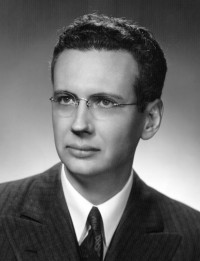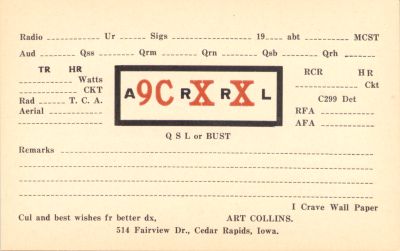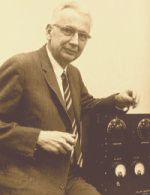N What Year Did Art Collins Start His Radio Company?
A.A. Collins:
Story •••
Amateur Radio:
Arthur A. Collins - Story
| Early amateur radio operators were mainly hobbyists, only in that location was a sense of discovery during the infancy of radio that provided something more than. Radio was the new thing, comparable to what computers mean to technological whizzes in the 1980s. And similar the figurer hobbyists of today who are writing their own programs and building their own equipment, apprentice radio operators in the 1920s were contributing to the knowledge of practical aspects of radio fine art. Ane person caught upwardly in the excitement of radio was Arthur Andrew Collins. Born in Kingfisher, Oklahoma, on September nine, 1909, Collins moved to Cedar Rapids, Iowa, at an early on historic period when his begetter, Merle (or M.H. as he preferred to see information technology written), established The Collins Farms Company at that place. With the Collins Farms Company, M.H. Collins brought new ideas to the stoic profession of farming. The elderberry Collins reasoned that the efforts of scientists and engineers could do for farming what they did for near every other industry in America. "Why non industry food for the American consumer as cheaply equally motor cars and radios are manufactured?" Chiliad.H. asked in a publication which explained his new ideas. "Why not produce food on a large scale by intensive farming methods in Iowa, where high yields could be obtained and at a low cost?" The primary object of the subcontract visitor was to produce grain at low cost. G.H. Collins felt that too many farmers mixed grain production with livestock raising, and equally a event, both were unprofitable. |  |
| He implemented his plans by convincing landowners he could improve the profitability of their tenant farms. Farms of 160 to 320 acres were planted to a unmarried ingather and were rotated as a single tract in a unit of measurement grouping of farms, each embracing i,500 to ii,000 acres. Each unit of face-to-face farms was put under the supervision of a salaried foreman who directed the tractor operators. The nearly modern machinery was employed for every performance - 4-row cultivators rotary hoes, deep disc plows, two-row corn pickers, fast trucks for marketing crops, and semi-trailers for moving machinery. For maximum use of all this new machinery, electrical lights were placed on the tractors, assuasive round-the-clock operation. Other practices initiated by The Collins Farms Company included installing drainage tile, erecting fire-proof ventilated grain storage bins, and using legumes to supervene upon nitrogen in the soil. At its superlative the company operated 60,000 acres of farmland in 31 Iowa counties, with wealthy businessman G.H. Collins at the helm of the corporation. At virtually the historic period of nine, Arthur Collins became deeply interested in the new curiosity of radio, although at get-go M.H. obviously did not call back highly of his son'southward tinkerings with radio. Arthur and another early boyhood radio devotee, Merrill Lund, fabricated their first crystal receivers at the Lund home at 1644 D Artery in Cedar Rapids. The sets used variable condensers inside a tube. Merrill'south father worked in the tube department at Quaker Oats Co. and made tubes of the size the boys needed. Using thumb tacks for contact points, they wrapped wire effectually the tubes. From iron plates they fashioned their own transformers, and rigged a threescore-human foot spark antenna with a atomic number 82-in through a basement window of the Lund dwelling house. Merrill's male parent asked them to discover some other location for their equipment later on lightning struck the radio set and blew it upwards. Arthur brought over two coaster wagons and the two boys transported the damaged equipment to the Collins home at 1725 Grande Avenue. Although Chiliad.H. did not approve of the mess information technology was going to cause, Arthur hauled the equipment to his room once his father was out of sight. "I used a Quaker Oats box to wind the tuning coil and used a Model T spark coil," he told a New York Times reporter in 1962. "The main piece of the station'southward machinery was the transmitter. Other parts of the station were recruited from a rural telephone service. The way we calibrated was to pick up signals from WWV (the Navy's station in Arlington, Virginia)." Arthur also used pieces of coal or coke for a rectifier, drinking glass towel racks for insulators and a toy motor. Those early efforts reflected a lot of experimenting that led to successively more reliable, higher-performance radios. Another adolescence friend in Cedar Rapids who also had an interest in radio was Clair Miller. The article quoted another neighbour's recollection of early days in the Collins family neighborhood: "We sensed that Arthur was dissimilar, simply we did non know that he was a genius. When the residue of united states were out playing cowboy and Indian, Arthur was in the house working on his radios." 1 day Arthur's mother invited the neighborhood boys into the Collins home. "I recollect she did then because she wanted us to realize that Arthur was different from the remainder of us. We went upstairs to come across what he was doing. He had a room that overlooked the thou. It was loaded with radio stuff. We knew a trivial about radio. We had been playing effectually with crystal sets ourselves. Merely Arthur had one wall covered with dials and switches, everything nether the sun." The Federal Radio Commission, the predecessor to the Federal Communications Commission, passed a radio human activity whereby amateurs could become licenses. Arthur took the exam and got his license in 1923 at the age of 14. Equally M.H. Collins recognized his son'southward talent and ambition toward radio, he looked for means to assistance with Arthur's hobby. In about 1924, Arthur's begetter purchased a new tube costing $135 and other high voltage equipment. "When I was a youngster there were 2 real agile amateurs (in Cedar Rapids)," Arthur recalled. "One was Henry Nemec and the other was Clark Chandler." Collins and Leo Hruska, another friend who had constructed a crystal receiver, used to receive the stations of Nemec and Chandler, and considered their talks with the more than experienced radio operators quite an achievement. Nemec recalled how he kickoff met the young boy with the extensive radio cognition. Chiliad.H. Collins had asked Nemec to see with his son so Nemec could teach Arthur some of what he knew virtually amateur radio, "Simply there wasn't much that he didn't already know," Nemec said. In a 1978 interview for an article most Henry Nemec in the Cedar Rapids Gazette, Arthur Collins recalled the early on days when he purchased a vacuum tube from Nemec, and several years subsequently when Nemec, who worked for the police section, and another patrolman, Frank Bukacek, parked their team auto in front of Collins' house while the iii were inside talking radio. Collins said he, Nemec and Bukacek got together so frequently, and the squad car was parked in front of the house and then often, that neighbors began to wonder whether Collins was in some kind of problem with the constabulary. At the time there was little formal instruction in the science of radio. Several two-day curt courses were given at Iowa State College at Ames, and Arthur is said to take attended the first of these while still wearing knickers. Carl Mentzer later on sponsored a course in radio at the Academy of Iowa. These courses, forth with several periodicals, including Wireless Age and QST, comprised about of the electric current radio noesis of the fourth dimension, other than word-of-mouth information. By the time he was a teenager, Arthur had constructed an apprentice radio station using purchased components, make-shift materials and his own ingenuity. Arthur'southward family had moved to a new home at 514 Fairview Drive, and his equipment moved with him. | |
 circa 1925 | Past the historic period of 15, Collins had communicated with other amateur "hams" in the United States and many foreign countries. The custom of exchanging postcards after a contact was made had already been established in the amateur world, and one wall of Collins' attic room was covered with so-called QSL cards. One card from Australia came from a radio operator who regarded America's prohibition of booze as a joke. "How does it feel to stay sober?" were the words the Australian ham wrote to fifteen-year-erstwhile Arthur. And during a contact with a person in Chile, the South American operator asked to be excused from the radio conversation because a volcano was erupting and interfering with the talk. "He referred to it as if it was in his backyard," Collins told a Cedar Rapids Gazette reporter in 1925. |
| The reporter, Gladys Arne, had gone to the Collins home to talk with the xv-yr-old boy because he had made a radio contact that put him on the front pages of newspapers all over the country. During the wintertime of 1924-25, Collins had become familiar with John Reinartz, a 31-year-old German immigrant who was prominent in radio circles because he developed a "tuner" or receiver capable of anticipated selectivity and reception. Reinartz had authored several articles on the subject field for radio magazines. Reinartz and Collins carried on experiments, particularly in the use of short wavelengths. Considering of Reinartz's radio success, he was chosen every bit the radio operator for a scientific expedition to the continent of Greenland. The MacMillan expedition set sheet from the coast of Maine on the ships Bowdoin and Perry in early 1925. Ane of the explorers was U.S. Navy Lt. Cdr. Richard E. Byrd. The plan was for the Bowdoin to make daily radio reports to the U.Southward. Naval radio station, but considering of atmospheric problems, the land station in Washington, D.C., was unable to consistently receive Reinartz'due south messages. Then discussion spread that a 15-year-old boy in Cedar Rapid'southward had made contact with the trek. Throughout the summer of 1925, Arthur Collins achieved a task that fifty-fifty the U.S. Navy found difficult. Using a ham radio that he himself had built, he talked by code with Reinartz in Greenland night after night. His signals reached the trek more clearly than any other. Afterwards each broadcast, immature Collins took the messages from the expedition downwards to the Cedar Rapids telegraph part and relayed to Washington the scientific findings that the exploratory group had uncovered that 24-hour interval. Collins' exclusive contact with the expedition soon became a nationwide news story that won him acclamation as a radio wizard. The August 4, 1925 Cedar Rapids Gazette told the story: One week afterward, a follow-upwards commodity in the Gazette concluded: "Though simply 15, he is true to his trust. For he hopes to realize smashing radio ambitions, by and by." At the age of 16, Collins was asked to write a technical article for Radio Age which was published in the May, 1926 outcome. 1 statement in that article foreshadowed the motivational force which was to pb him to "neat radio ambitions." "The real thrill in amateur work comes not from talking to stations in afar lands … but from knowing that by conscientious and painstaking work and by diligent and systematic study you lot accept been able to accomplish some feat, or institute some fact that is a new step toward more than perfect communication." Arthur'south reputation in the radio world grew. Radio operators around the land who had heard almost his contacts with the MacMillan trek wrote to him to ask how he did it. | |
| Collins continued his electronics instruction past taking courses at Amherst College in Massachusetts, Coe College in Cedar Rapids, and the University of Iowa in Iowa City. In 1927, he and two friends organized an expedition of sorts of their own. Collins, Paul Engle, and Winfield Salisbury outfitted a truck with short moving ridge transmitting and receiving equipment and took a summertime trip to the southwest states. Using power of 10 watts they conducted experiments in connection with the U.S. Naval Observatory in Washington, D.C. Leo Hruska stayed backside in Cedar Rapids to operate the base station for the study. Like Collins, both Engle and Salisbury would afterwards proceed to achieve recognition in their item chosen fields - Engle as a poet and professor at the University of Iowa, and Salisbury as a noted physicist who would brand significant contributions to studies initiated by Collins. In 1930, Collins married Margaret Van Dyke. By the end of 1931 he had gear up up a shop in the basement of their home at 1720 6th Avenue Southward.E., previously the habitation of his grandparents. Arthur began to produce transmitters to order. |  |
| When the depression hit with total force in 1931, 23-year-old Collins turned his hobby into a vocation. "I picked what I was interested in," he told Forbes magazine years afterward, "and looked for a way to make a living." This was the beginning time radio transmitting apparatus, of whatever power output, was available for purchase every bit an assembled and working unit. In fact, components were hard to come past; they varied widely in characteristics, and at that place was piddling, if any, pattern to their construction. Almost hams had their radio equipment scattered effectually a room, normally in a basement or attic where the sight of tubes and wires wouldn't ataxia up living areas of a domicile. Their equipment was strictly functional, almost to the signal of inefficiency. Collins' ham gear was designed to eliminate the clutter past packaging the equipment in neat units. The concept proved that correctly engineered construction not only stabilized the circuitry only as well fabricated its beliefs anticipated. Collins designed circuits, made chassis, mounted and wired in components, tested, packed and shipped each unit. Because the gear was precisely engineered and well-built with the best parts bachelor, it gave years of trouble-free service. A later commodity in the New York Times quoted a ham as maxim, "Collins brought us upwardly from the cellar and put the states into the living room." The industrial philosophy of Collins products "quality" was established at the very commencement. The first advertisement for this new line of products appeared in the January, 1932 outcome of QST, with the firm name given every bit Arthur A. Collins. Two problems later, in March, 1932, the firm name appeared as Collins Radio Transmitters with Arthur's proper name and telephone call number below. Both notices were two-inch advertisements, only by May the size was increased to six inches. In October the first full-page advertisement appeared and by December, the firm's proper noun was listed every bit Collins Radio Company. Long-fourth dimension friend Jiggs Ozburn recalled his first meeting with Collins. "I first met Arthur Collins at a ham club meeting at his house (factory in basement). I hadn't finished high schoolhouse and he hadn't finished college (he never did). Art had been making ham transmitters for about a year. He was alpine and slender and very serenity. He came from a well-to-exercise family unit whose fortune was taking a beating in those depression years, so Art was pretty much on his own." The Cracking Depression, which began later the stock market crash in 1929, was having a devastating effect on the Collins Farms Company. In 1931, G.H. Collins sold the house to an east coast insurance company. Arthur originally started his visitor as sole owner with only one employee, Clair Miller, who had just been graduated from Iowa Land Higher. But as his business organization grew, he added personnel, including some who came from his father's farm visitor. Among them were John Dayhoff and Ted Saxon. Orders came in and the visitor grew. In 1933, Collins Radio Company moved out of the basement factory and into leased space at 2920 First Avenue in Cedar Rapids, now headquarters for the local Salvation Army. Business in general in 1933 was not expert, to put it mildly, but radio had come of age, and Collins recognized the need for advancement in the radio communications field. 1 Sat morning that twelvemonth, Collins telephoned Arlo Goodyear and offered him a task for 2 months if he was willing to work on Sundays. Out of work for months and with a wife and baby, Goodyear jumped at the opportunity. "There it was in the heart of the Depression and he was asking me if I minded working on Lord's day," Goodyear subsequently wrote. "I would have worked on Shrove Tuesday." Collins and his work force of one arrived at the building simply to discover that neither had a key to go into the basement area, where the company was to begin production the next forenoon. Collins looked at the door, looked at Goodyear, and said, "Well, nosotros've got to become going. Catch me and then I won't fall on my head." Collins charged the locked door and the new institute got underway with a blindside and a shattered front door. On September 22, 1933, with eight employees and $29,000 in capital, Collins Radio Company became a corporation under the laws of the State of Delaware. At that time Delaware had some of the well-nigh modern corporation laws in the land, and many businesses were officially organizing in that location, although their actual facilities were located in other states. (On May thirteen, 1937, the company reorganized as an Iowa corporation.) | |
| Reprinted from The First 50 Years … A History of Collins Radio Visitor past: Ken C. Braband. ©1983 Communications Section, Avionics Group, Rockwell International, Cedar Rapids, Iowa | |
Source: https://collinsaerospacemuseum.org/aa_collins/aac_story.php
0 Response to "N What Year Did Art Collins Start His Radio Company?"
Post a Comment